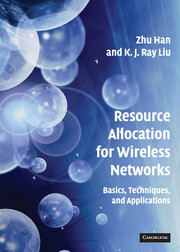5 - Multiple Access and Spectrum Access
from Part I - Basics Principles
Published online by Cambridge University Press: 05 August 2012
Summary
Introduction
The available wireless radio resources are very limited, while there are an increasing number of mobile users. It is necessary to share a communication channel or physical communication medium among multiple users. The multiple-access scheme is a general strategy to allocate the limited resources, such as bandwidth and time, to guarantee the basic QoS, improve the system performances, and reduce the cost for the network infrastructures. Whereas multiple access considers the problem of allocating limited radio resources to multiple users, spectrum access decides whether an individual user can access a certain spectrum.
The basic idea of the multiple-access scheme is to combine several signals for transmission on a certain shared medium (e.g., a wireless channel). The signals are combined at the transmitter by a multiplexor (a “mux”) and split up at the receiver by a de-multiplexor. Based on how to divide the limited radio resources to multiple users, the multiple-access schemes can be classified as time-division multiple access (TDMA), frequency-division multiple access (FDMA), code-division multiple access (CDMA), space-division multiple access (SDMA), and others.
The multiple-access schemes need to be dynamically coordinated for a number of reasons: The users' data flows might not have data to transmit, the channel conditions are different for different users, and the QoS such as the delay constraints are different for different types of payloads. Based on how to coordinate access for the radio resources, multiple-access schemes can be classified into two types: scheduling and random access. In scheduling, there is a centralized control, the base station, that controls which user can transmit by using specific resources such as the bandwidth at different times. In random access, there is no such centralized control.
- Type
- Chapter
- Information
- Resource Allocation for Wireless NetworksBasics, Techniques, and Applications, pp. 99 - 134Publisher: Cambridge University PressPrint publication year: 2008



